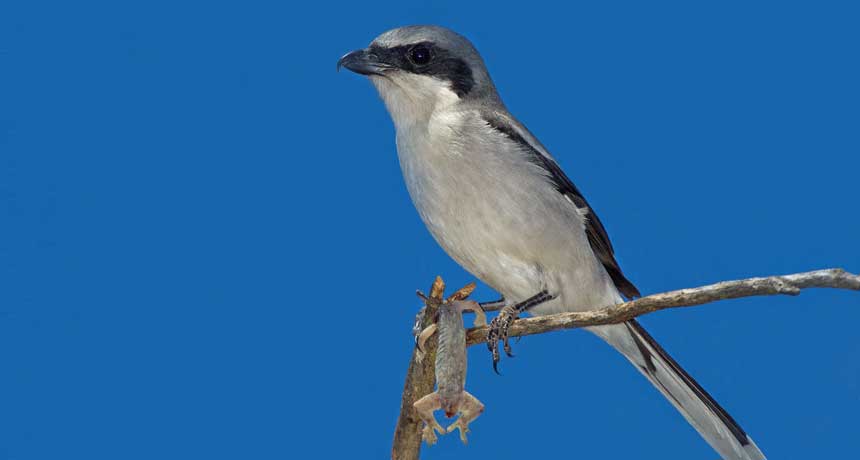These songbirds can fling and shake mice to death
This meat-hunting bird’s shake might be worse than its bite

The San Clemente loggerhead shrike lives on San Clemente Island off the California coast. This mild-looking songbird delivers potentially fatal shakings to small vertebrates — such as the dead lizard it now holds.
Daniel W. Clark, U.S. Navy
By Susan Milius
Bite a mouse in the back of the neck. Don’t let go. Now shake your head at a frenzied 11 turns per second, as if saying “No, no, no, no, no!”
You have just (sort of) imitated a loggerhead shrike (Lanius ludovicianus). It’s already known as one of North America’s more ghoulish songbirds. That’s because it impales dead bodies of prey on thorns and barbed wire. But that’s not where the gory story ends.
Once the shrike hoists its prey onto some prong, the bird will tug it downward. “It’s on there to stay,” says Diego Sustaita. As a vertebrate biologist, he studies animals with backbones. He has watched a shrike about the size of a mockingbird steadying a skewered frog like a kabob for the grill. A bird might dig in right away. It might keep the meal for later. Or it might just let that poor dead frog sit around as proof of its appeal as a successful hunter.
Shrikes eat a lot of hefty insects. The birds also catch rodents, lizards, snakes and even other types of small birds. The limit on what they can carry off may be close to the shrike’s own weight. A 1987 paper reported on a shrike killing a cardinal almost as big as it was. The shrike couldn’t carry the dead weight more than a few meters (yards) at a time and finally gave up.
Recently, Sustaita got a rare chance to video how the loggerheads kill their prey.
The species’ numbers are low. Scientists say these birds are “near threatened” with extinction. So to aid in the species’ survival, conservation managers are breeding one loggerhead subspecies on San Clemente Island. That’s about 120 kilometers (75 miles) west of where Sustaita works at California State University San Marcos. Sustaita set up cameras around a cage where the birds are fed. That let him film shrikes, beak open, lunging to catch dinner. “They’re aiming for the prey’s neck,” he found.
That’s a very shrikey thing. Falcons and hawks attack with their talons. Shrikes, though, evolved on the songbird branch of the bird tree — without such powerful grips. So shrikes land on their feet and attack with their hooked bills. “The bite happens at the same time the feet hit the ground,” Sustaita says. If the mouse somehow dodges, the shrike pounces again, “feet first, mouth agape.”
Reading several decades of gruesome shrike papers, Sustaita first believed the real killing power came from the bird’s bill. It has bumps on the side. As it dives into the neck, it wedges that beak between neck vertebrae, biting into the prey’s spine. Shrikes definitely bite. However, based on videos, Sustaita now proposes that shaking may help immobilize, or even kill, the prey.
Sustaita’s team discovered that San Clemente shrikes fling their mouse prey with a ferocity that reached six times the acceleration due to Earth’s gravity. That’s about what a person’s head would feel in a car crash at 3.2 to 16 kilometers (two to 10 miles) per hour. “Not superfast,” Sustaita acknowledges. But it’s enough to give someone whiplash. The team described what it learned from these videos September 5 in Biology Letters.
That much shaking could be even more dangerous to a small mouse. Videos showed that the mouse’s body and head were twisting at different speeds. “Buckling,” Sustaita calls it. Just how much damage twisting does versus the neck bite remains unclear. But there’s a whole other question: In the process, how does a shrike manage not to shake its own brain to mush?







